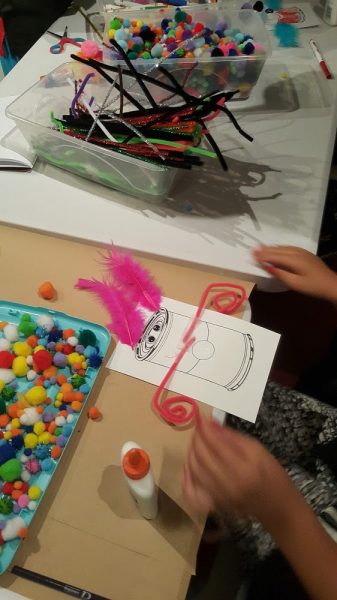Expression through mark-making, gesture, and color is a core part of being human. From the oldest cave paintings on the Iberian Peninsula to a child’s first marks with a crayon, art-making is one of the many means of expression that humans engage with to understand and interpret the world around them. Visual art reaches beyond written and spoken language to access the emotional and psychological inner world of both the maker and the viewer. By creating this dialogue, there is a place to experience the richness and nuance of one’s inner life, foster emotional intelligence, and support mental health.
“Art education is a great way to get kids to explore their own interests and introduces them to the larger world around them,” says Jennifer Lammey, CSU art education alumni and visual arts teacher for the St. Vrain Valley School District. “It creates a safe place to learn about themselves and be creative without a lot of pressure. Art-making naturally raises questions, and it helps kids to find answers to them creatively. It also helps them explore issues, whether it's identity or race or environmental issues, and gives them a visual language to talk about those issues.”
When individuals have a way to express themselves, their community benefits from their well-being. Having access to visual art and experiencing the creation of art helps humans contextualize their experiences and connects them to others through the expression of shared identity. Creating these connections and mutual understanding through art supports interpersonal connection, increases empathy, and facilitates healthy relationships between individuals and society.
Early art education is fundamental to the development of these emotional and psychological skills. The Art Education program in the Department of Art and Art History engages with art departments in local school districts through community-based art education to help young people practice these important skill sets. Community-based art education is when the teacher acts as a facilitator and mediator between the students and the community in which they live. It is a collaboration between students and their teacher, and the curriculum is usually tailored to the students' needs. This can take the form of organized community art programs to improve art skills or outreach programs to empower special groups of people.
“Community-based art education encourages learners to make connections between their art education in a classroom setting and its application in the community beyond school, with demonstrable examples of how the arts impact responsible citizenship,” says Patrick Fahey, associate professor of art education. “There are many approaches to work in and effect change in the community. Such approaches promote contextual learning about local art and culture, at the same time helping the community and highlighting the needs of marginalized citizens.”
CSU art education students craft meaningful educational experiences that positively impact primary and secondary students in the Fort Collins community and beyond through programs like BRAINY (Bringing Arts Integration to Youth) and Family Day.
“Through the efforts that we made on BRAINY, we hope to create an inclusive and positive community for people of any race, ethnicity, or social class to have the equal right to make art together at the museum. This helps our students and participants to know how to work with diversity and be included in diversity,” says Claire Chien, assistant professor of art education.
Students and families participate in BRAINY and Family Day, hosted by the Gregory Allicar Museum of Art. Photos from 2019 events.
BRAINY is a program of the Gregory Allicar Museum of Art that provides hands-on experience in all aspects of art, and supports ongoing, active art education in K-12 classrooms. By bringing children to a university campus, BRAINY demonstrates the role arts play in our community and culture. University students from the Department of Art & Art History and the School of Music, Theatre, & Dance develop programming that engages students from Title I schools in northern Colorado who may not otherwise have access to the visual and performing arts.
Family Day is another valuable program at the Gregory Allicar Museum of Art. It is a free, open to the public, bilingual event offered in English and Spanish where art education students give tours to K-12 students and their families and facilitate art-based activities. Since its inception, the museum has brought more than 1500 Family Day participants into the museum to experience the museum’s collection and the University Center for the Arts, thereby contributing to the health of Colorado’s Front Range community.

“As an academic museum, the CSU community is at the core of all that we do,” says Lynn Boland, Gregory Allicar Museum director and chief curator. “But our community programming is where everything we do comes together, and I think the museum's BRAINY and Family Day programs may be where that shines the brightest. Seeing CSU students, faculty, and staff all coming together to engage, educate, and inspire children and families is, for me, the perfect embodiment of the role of a museum at a land-grant university, serving as a community gateway.”
By giving K-12 students tangible experiences of art and museums, especially those from low-income families or other communities who would otherwise not have access to art and art museums, these students engage with art-making as an accessible, tangible, and essential part of the human experience. Art connects people to their communities by contextualizing their experiences and seeing themselves reflected back.
“Programs like BRAINY show that art really is for everyone,” Jennifer Lammey continues. “We ask them ‘what do you notice? What do you see?’ By focusing on the kids’ experience of art and allowing them to lead the conversation, it fosters a spark for art and makes it more accessible.”
